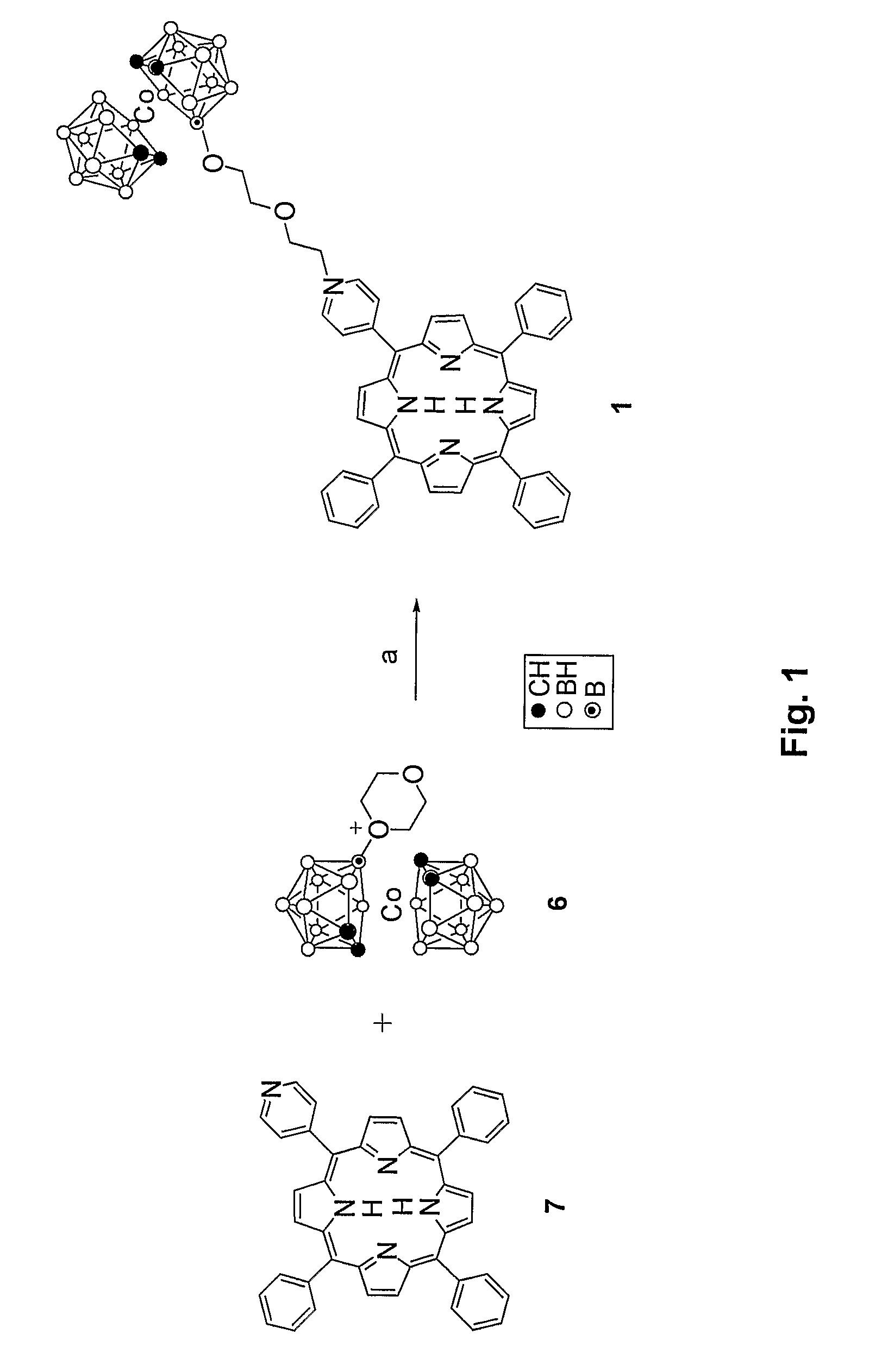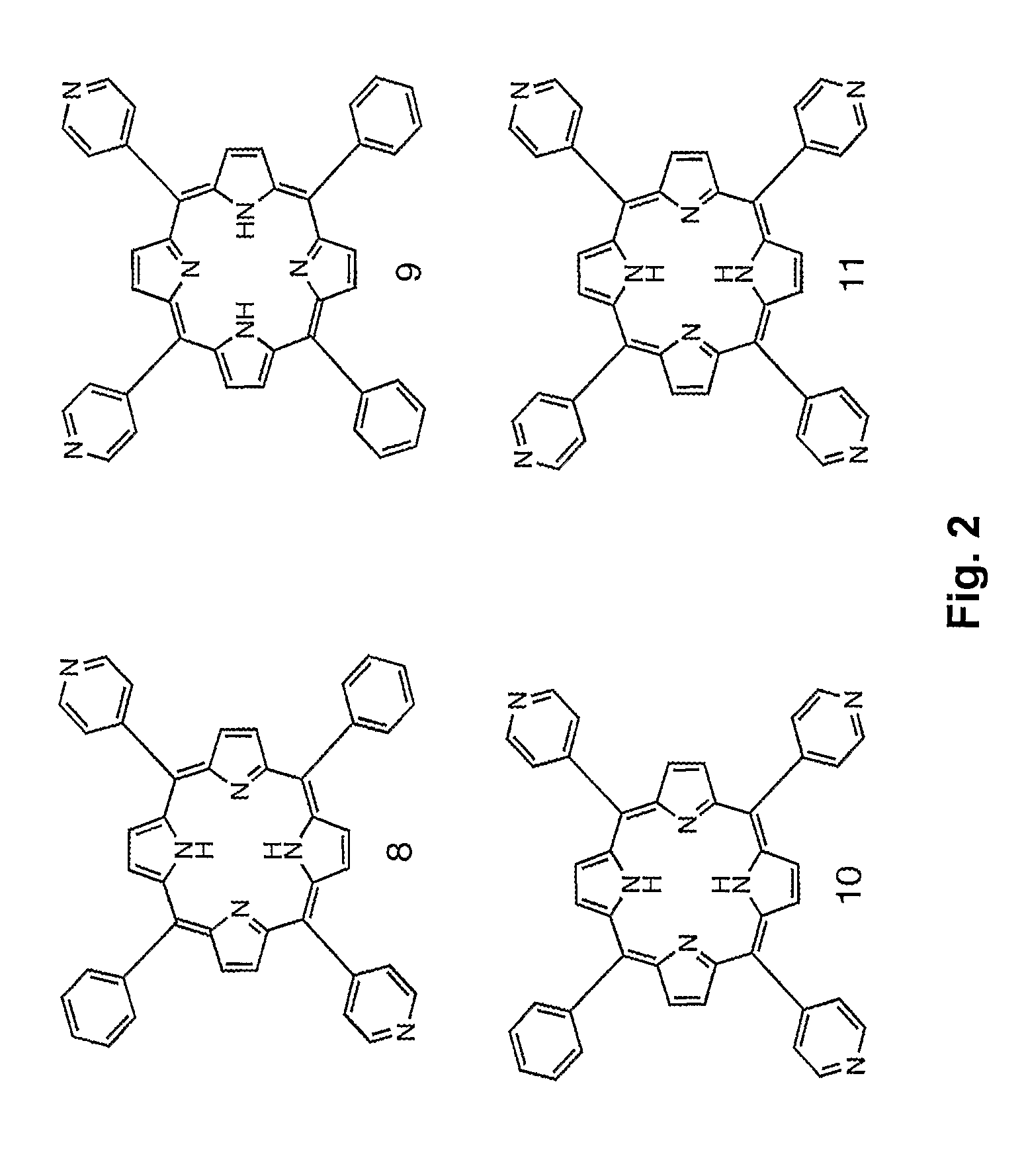Boron-containing porphyrin compounds and their uses
a porphyrin compound and boron-containing technology, applied in the field of porphyrin compounds, to achieve the effect of high yield, high tumor selectivity, and high yield
- Summary
- Abstract
- Description
- Claims
- Application Information
AI Technical Summary
Benefits of technology
Problems solved by technology
Method used
Image
Examples
example 1
[0048]Starting Materials, and Analyses. All syntheses were monitored by TLC using 0.25 mm silica gel plates, with or without UV indicator (Merck 60F-254). Silica gel from Sorbent Technologies, 32-63 μm, was used for flash column chromatography. 1H— and 13C-NMR were obtained on either a DPX-250 or a ARX-300 Bruker spectrometer. Chemical shifts (δ) are given in ppm relative to acetone-d6 (2.05 ppm, 1H; 207.07 ppm, 13C), unless otherwise indicated. Electronic absorption spectra were measured on a Perkin Elmer Lambda 35 UV-Vis spectrophotometer. Fluorescence spectra were measured on a Perkin Elmer LS55 spectrometer. Mass spectra were obtained on an Applied Biosystems QSTAR XL. All solvents were purchased from Fisher Scientific (HPLC grade) and used without further purification. Zwitterionic [3,3′-Co(8-C4H8O2-1,2-C2B9H11)(1′,2′-C2B9H11)] (Compound 6) was prepared from the cesium salt of cobaltabisdicarbollide, obtained from Katchem Ltd (Czech Republic). The 5-(4′-pyridyl)-10,15,20-triphe...
example 2
Synthesis of Compound 1: 5-(4′-Cobaltacarboranepyridyl)-10,15,20-triphenylporphyrin
[0049]Porphyrin 7 (61.6 mg, 0.10 mmol) and compound 6 (61.5 mg, 0.15 mmol) were heated in 40 mL of chloroform / acetonitrile 1:1 for 12 h. Compound 1 was obtained in 98.4% yield (101.0 mg) as a purple solid. UV-Vis (acetone) λmax (ε / M−1cm−1) 418 (157,600), 515 (10,100), 551 (5,300), 590 (3,400), 646 (2,600). 1H NMR (acetone-d6): δ 9.73 (d, 2H, J=6.7 Hz, o-PyrH), 9.10-9.07 (m, 4H, b-H), 9.00 (d, 2H, J=4.8 Hz, m-PyrH), 8.90 (s, 4H, b-H), 8.28-8.24 (m, 6H, o-PhH), 7.86-7.76 (m, 9H, m,p-PhH), 5.34-5.30 (m, 2H, NCH2), 4.51-4.42 (m, 2H, OCH2), 4.06-4.03 (m, 4H, OCH2), 3.84-3.82 (br s, 4H, carborane-H), 1.6-3.0 (br, 17H, BH), −2.74 (s, 2H, NH). 13C NMR (acetone-d6): δ 160.1, 144.8, 142.2, 135.1, 133.6, 128.9, 127.7, 1230, 122.1, 113.3, 73.0, 69.7, 61.8, 52.5, 46.9. HRMS (MALDI-TOF) m / z 1026.5713, calculated for C51B18H58N5O2Co 1026.5739.
example 3
Synthesis of Compound 2: trans-5,15-di(4′-cobaltacarboranepyridyl)-10,20-diphenylporphyrin
[0050]Porphyrin 8 (16.0 mg, 0.026 mmol) and compound 6 (43 mg, 0.10 mmol) were heated in 40 mL of chloroform / acetonitrile 1:1 for two days, yielding 34.1 mg (91.1%) of Compound 2. UV-Vis (acetone) λmax (ε / M−1cm−1) 422 (129,400), 516 (8,400), 554 (5,200), 590 (3,400), 651 (2,800). 1H NMR (acetone-d6): δ 9.76 (d, 4H, J=6.7 Hz, o-PyrH), 9.13-9.09 (m, 8H, b-H), 9.04 (d, 4H, J=4.9 Hz, m-PyrH), 8.29-8.26 (m, 4H, o-PhH), 7.91-7.83 (m, 6H, m,p-PhH), 5.34-5.32 (br m, 4H, NCH2), 4.44-4.42 (br m, 4H, OCH2), 4.06 (br s, 4H, OCH2), 4.02 (br s, 4H, OCH2), 3.87-3.83 (m, 8H, carborane-H), 1.6-3.0 (br, 34H, BH), −2.80 (s, 2H, NH). 13C NMR (acetone-d6): δ 160.0, 145.3, 142.2, 135.5, 133.8, 129.5, 128.2, 123.2, 115.5, 73.7, 70.4, 62.6, 53.1, 47.6. HRMS (MALDI-TOF) m / z 1438.9027, calculated for C58B36H86N6O4CO2 1438.8987.
PUM
| Property | Measurement | Unit |
|---|---|---|
| depths | aaaaa | aaaaa |
| concentration | aaaaa | aaaaa |
| pore size | aaaaa | aaaaa |
Abstract
Description
Claims
Application Information
 Login to View More
Login to View More - R&D
- Intellectual Property
- Life Sciences
- Materials
- Tech Scout
- Unparalleled Data Quality
- Higher Quality Content
- 60% Fewer Hallucinations
Browse by: Latest US Patents, China's latest patents, Technical Efficacy Thesaurus, Application Domain, Technology Topic, Popular Technical Reports.
© 2025 PatSnap. All rights reserved.Legal|Privacy policy|Modern Slavery Act Transparency Statement|Sitemap|About US| Contact US: help@patsnap.com



